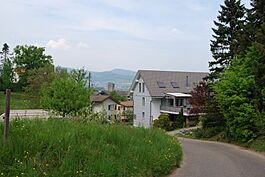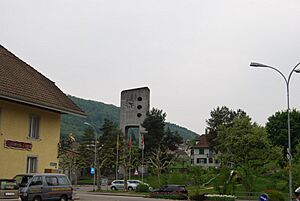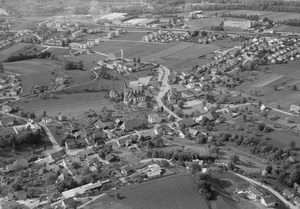Dulliken facts for kids
Quick facts for kids
Dulliken
|
||
|---|---|---|
 |
||
|
||
| Country | Switzerland | |
| Canton | Solothurn | |
| District | Olten | |
| Area | ||
| • Total | 6.04 km2 (2.33 sq mi) | |
| Elevation | 436 m (1,430 ft) | |
| Population
(Dec 2020 )
|
||
| • Total | 5,083 | |
| • Density | 841.6/km2 (2,179.6/sq mi) | |
| Postal code |
4657
|
|
| Surrounded by | Däniken, Obergösgen, Oftringen (AG), Olten, Starrkirch-Wil, Walterswil, Winznau | |
| Twin towns | Ammerndorf (Germany) | |
Dulliken is a town in Switzerland. It is located in the Olten district, which is part of the Solothurn area. Dulliken is known as a municipality, which is like a local government area.
Contents
History of Dulliken
Dulliken is an old town! It was first written about way back in 924. Back then, it was called Tullinchova. Later, in 1173, people called it Tullichon.
Geography and Nature
Dulliken covers about 6 square kilometers (2.3 square miles). A big part of the land, almost 40%, is used for farming. About a third of the area is covered by forests. The rest of the land has buildings, roads, or rivers.
Most of the built-up areas are homes and other buildings. There are also some industrial buildings and roads. The forests are mostly thick woods. The farming land is used for growing crops and for pastures where animals graze.
Dulliken is located on the northern side of the Engelberg mountain. It includes the main village of Dulliken, a smaller area called Schachen, and some farmhouses on the mountain.
Dulliken's Coat of Arms
A coat of arms is like a special symbol for a town or family. Dulliken's coat of arms shows a black bird called a Jackdaw. This bird is sitting on a green wreath of leaves. The background color of the shield is gold.
People of Dulliken
Dulliken has a population of about 5,000 people. Many people in Dulliken speak German, which is the most common language. Other languages spoken include Italian and Turkish.
In Dulliken, about a quarter of the people were born there. Many others were born in the same part of Switzerland or in other parts of the country. Some people have moved to Dulliken from other countries.
The population of Dulliken has changed over time. You can see how the number of people has grown and changed in the chart below:

Economy and Jobs
Many people in Dulliken have jobs in different areas. Some work in farming. Others work in factories or construction, which is called the secondary sector. The largest number of jobs are in the tertiary sector. This includes jobs in shops, transportation, hotels, restaurants, healthcare, and education.
Many people who live in Dulliken travel to other towns for work. Also, some people come into Dulliken from other places to work. Most people use a private car to get to work, but many also use public transportation.
Religion in Dulliken
In Dulliken, many people are Roman Catholic. A good number also belong to the Swiss Reformed Church. There are also people who follow other Christian churches, Islam, Buddhism, and Hinduism. Some people do not belong to any church.
Transportation
Dulliken has its own train station, called Dulliken railway station. It is on the train line that connects Olten and Aarau. This makes it easy for people to travel to and from Dulliken.
Education and Learning
In Dulliken, many people have finished high school. Some have also gone on to get higher education from a university or a special college.
The school system in Solothurn canton starts with two years of optional Kindergarten. After that, students attend six years of primary school. Then, they go to three years of lower secondary school. There are also advanced schools available after that.
Dulliken has a local library called Gemeindebibibliothek Dulliken. It has many books and other media for people to borrow. The library is open several days a week for everyone to enjoy.
See also
 In Spanish: Dulliken para niños
In Spanish: Dulliken para niños






